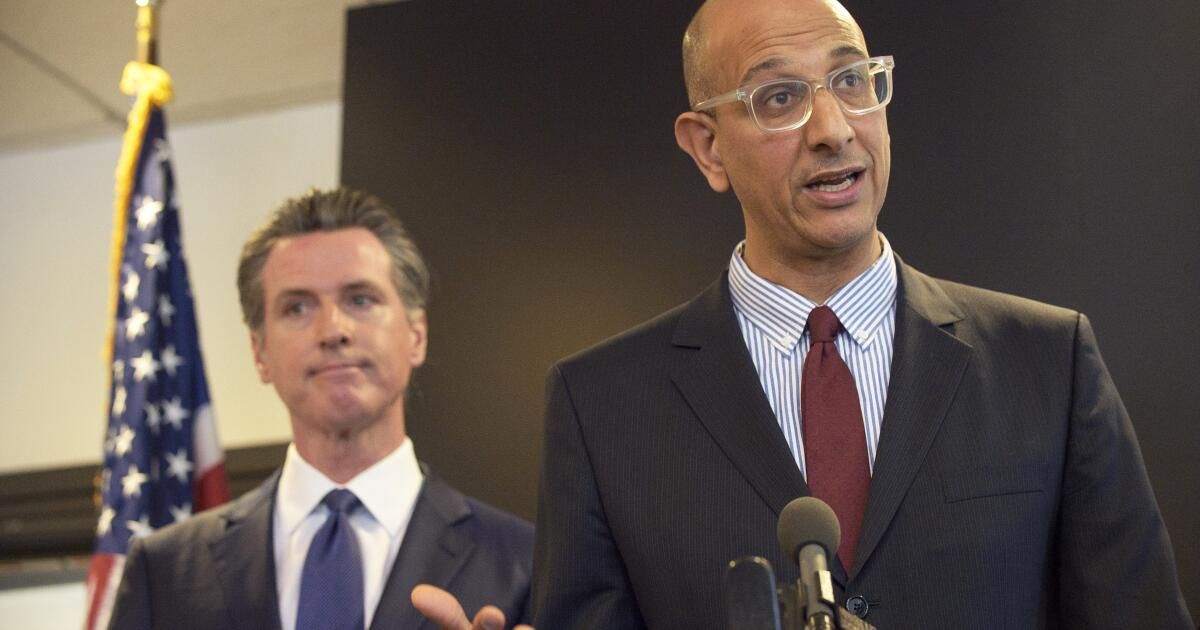Dr. Mark Ghaly will step down as director of the California Health and Human Services Agency after an eventful tenure that included the outbreak of the COVID-19 pandemic, Gov. Gavin Newsom announced Friday.
Newsom called Ghaly “a driving force for transformational change to make health care more affordable and accessible,” whose leadership during the pandemic “saved countless lives and set the stage for our state’s strong recovery.” The governor’s office also credited Ghaly with reinventing Medi-Cal, California’s Medicaid program; overhauling the state’s behavioral health system; and launching efforts to make crucial medications more affordable, among other initiatives.
Ghaly was appointed in 2019 to lead the state agency, which oversees a number of California departments and offices that handle public health, mental health, assistance for people with developmental disabilities and a variety of other health and social services.
Ghaly will remain at the agency through the end of the month. Newsom will appoint Kim Johnson, director of the California Department of Social Services, to replace Ghaly in October. The Times spoke with Ghaly this week about her tenure.
This conversation has been edited for brevity and clarity.
What were the three biggest challenges you faced at Health and Human Services, and what are the three biggest challenges facing your successor?
One of the big challenges has been, under the governor's leadership, managing the state's response to COVID-19, which is obviously huge. The second, I think, is tackling a comprehensive review of our safety net… And the third aspect has been how do we make sure that, for all Californians, we're moving forward to keep these basic needs, like health care, affordable…
The successor will certainly have to continue to implement the really thoughtful policy agenda that has brought together… this real tapestry of programs and services that, when successfully implemented, I think really changed the arc of the lives of many Californians, particularly the most vulnerable.
The focus on equity principles – I have no doubt that will continue to be a central point. And then on the last point, there are a lot of experts and detractors on the affordability agenda: Can we make thoughtful policy decisions and implement them to make things more affordable for Californians?
Having started a year before the pandemic, if you knew then what you know now, is there anything you would do differently in terms of the COVID response in California?
If you had told me we had to successfully navigate California, the largest state in the nation, with one of the lowest mortality rates from the disease, with a very thoughtful path to economic recovery, while simultaneously increasing and growing the California Health and Human Services Agency's investment by nearly 50% over these six years, I would have said, “Sign me up for that job any day of the week. What a privilege.”
But of course, during the pandemic there were things that happened that, as you go on and you look at them, you hope you can do something different in the future. And I would say that first on the list for me is how do we support young people with learning and school?
You'll remember that early on, the question came up about how to handle… schools as places where people get infected and go home and infect other vulnerable people. We were learning more about this airborne virus that was mutating as it went along. And we made decisions in this state to keep kids home. [to] We really leaned into virtual distance learning, and it stuck around a lot longer than I think people expected… And the governor put together a number of programs that supported their education in all kinds of ways.
But I think knowing what we know now about the virus and the duration of the pandemic, some of that information would have been helpful in those early days, weeks and months in relation to how we support children in schools.
During her time at the agency, we have seen some important changes in the way California handles serious mental illness: the opening of CARE Court and Senate Bill 43, which expanded the definition of serious incapacity for involuntary treatment… Do you think it is producing the change that was expected?
When I talk about the total transformation of the safety net, I can't think of a better topic, a single topic to focus on than behavioral health. Under Governor Newsom's leadership, we've moved from a focus on mental health to a focus on behavioral health, to include the very real need to focus on addictions and substance use disorders, their connection to issues like housing instability and homelessness, their connection to incarceration.
When I took this job, in my actual interview with the governor before I was appointed, we talked about how much we wanted to change the trajectory for people with serious mental and behavioral health issues, because in many ways, the destination often for individuals was jail, incarceration, prison…
[With CARE Court] Our goal was not just to get people in line, but to get people to the front of the service line who are so often left out in the cold… until they do something that gets them arrested, and then all of a sudden we start giving them some of the care they need, but often in the worst possible environment.
I think the governor's many programs that focus on behavioral health… when you step back and look at it all together, they're essentially giving Californians and local government tools that they never had to be able to dream differently and put together a program that, I think, really gives us a credible opportunity to catch people much earlier in their trajectories with the challenges of behavioral health conditions, rather than what we so often do…
I think we'll see these programs really bear fruit as they become more deeply rooted. [and] We worked on some of the obvious operational challenges.
California has been expanding Doctor, your Medicaid program, to cover many more people, but there are state Concerns of health care providers who do not pay them adequately, resulting in a shortage of suppliers willing to accept Medi-Cal patients. How should California fix that problem?
A: I often tell the governor, “Look, there are four basic things when you talk about health care: think about benefits, think about access, think about quality, and think about eligibility.” And I think the governor has addressed all of those areas…
We've made some pretty significant investments in some of what I'll call the base Medicaid rates, which have gone up to 100% or close to 100% of what Medicare pays in this part of the country. Because of some budget issues, we've had to put on hold some other investments that were planned for next year, but as the budget starts to improve, I hope that — I know that those will be a continued focus.
Keep in mind that Medicaid has many different ways for providers and plans to get paid… I think if you look at all of this, the opportunities to recruit providers to serve the Medicaid population are stronger than when Governor Newsom took office six years ago.
That said, there needs to be an ongoing balance and conversation about how to continue to support this program, because one in three Californians now relies on Medicaid. Many children — more than 33%, nearly 50% of children — rely on Medicaid. When you have such a vital safety net program, we need to continue to pay attention to those four elements: quality, access, eligibility and benefits.
Earlier this year, the Office of Health Care Affordability announced a goal of 3% annual growth in health spending, to be phased in gradually. How do you expect health care providers to achieve this goal, given pressures that have increased costs in the past, such as labour costs and inflation?
I think we're going to need to move away from our traditional views of how health care is managed. We're really going to have to make some decisions about how to move more things upstream, promoting prioritization of things like preventative care and primary care, helping to support other access points for people who are difficult to access, and frankly really looking at some of the benefits of each of the different entities across the health care delivery system…
We don't expect all Californians to be there all the time. There will be some conditions that will legitimately push the markets in a different direction.
But overall, if we don't pursue a goal that is aggressive and achievable, the affordability problem facing so many Californians will not only not improve, it will likely get worse.
Reporters covering the Capitol have Concerns raised Personally, it is not common for someone from the Department of Public Health to get on the phone. Why do these departments not usually speak directly to the media, rather than sending written statements?
Frankly, it's not so much a lack of interest in speaking directly to the media: interviews often allow managers and leaders to convey nuances and important points very clearly.
My experience has shown that very often the questions that journalists want answered need to be able to be answered very clearly in writing. That's why we've used it frequently, not to hide behind something or avoid the live interview, but because it seems and has been appropriate in many of those conversations or requests.
One of the things I know you've been working on lately is this state plan on services for Californians with developmental disabilities. In California, these services have long been coordinated through a system of nonprofit organizations called regional centers, What contract do you have with the state? Do you believe that system is working for Californians and their families? And if not, what do you think needs to change?
One of the biggest themes that was amplified during COVID was this notion of building trust through transparency… And in my time and experience, I’ve heard that loud and clear. [from consumers and their families] that this system is not as transparent as it can or should be, and I agree with that.
So part of the work of this new strategic plan… is to recognize that Governor Newsom did something unprecedented. He took a rate study from before he came into office and implemented it… We are on track to fully implement it soon. [Ghaly is referring to increases in rates paid to regional center vendors that provide services to people with disabilities] … To put it bluntly, given the level of investment, we should become a system much more capable of saying “yes” to consumers, rather than “no” or delaying.












